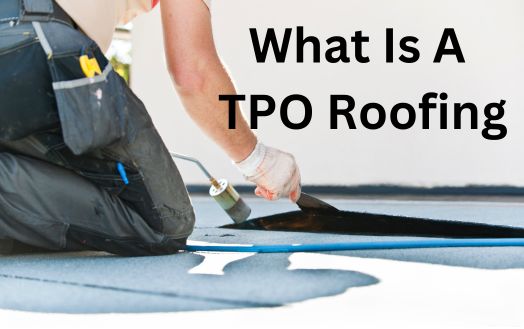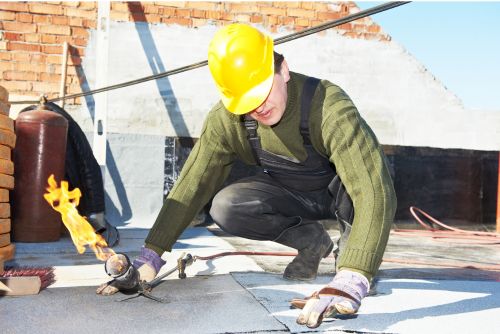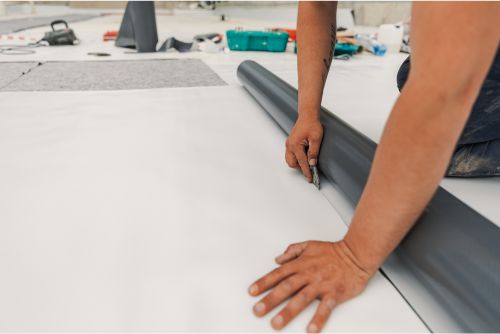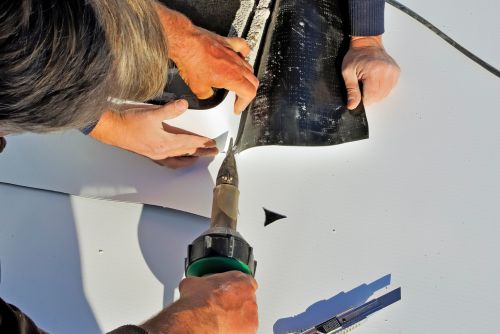
TPO roofing, short for thermoplastic polyolefin roofing, has been gaining popularity in the commercial roofing industry due to its durability, energy efficiency, and cost-effectiveness. This roofing material is commonly used for flat roofs, making it a preferred choice for commercial buildings. In this blog, we will explore what is a TPO roofing, including its composition, advantages, installation process, and more. If you’re considering TPO roofing for your commercial facility, read on to learn all about this versatile roofing solution.
TPO roofing is a type of roofing membrane made from a blend of polypropylene and ethylene-propylene rubber. This combination results in a durable and flexible material that is ideal for commercial roofing systems. The TPO membrane is designed to reflect UV rays, keeping the building cool during hot summer months. This energy-efficient feature not only provides comfort but also helps reduce cooling costs. TPO roofing can be installed as a single-ply membrane, providing a seamless and watertight barrier for flat roofs.
TPO roofing is a popular choice for commercial roofing due to its durability, energy efficiency, and affordability. It is a versatile roofing material that can be installed on both new construction projects and existing roofs. The material composition of TPO roofs includes a blend of polypropylene and ethylene-propylene rubber, which provides the necessary durability and flexibility. TPO roofs are commonly used on flat roofs, as they offer excellent commercial leak repair NJ, tears, and punctures. Additionally, TPO roofing systems can be mechanically attached or fully adhered, depending on the specific needs and requirements of the project.
TPO roofing has been around since the 1980s, but it has evolved over the years to become a popular choice for commercial roofing systems. The initial development of TPO roofing material aimed to create a roofing membrane that combines the best features of thermoplastic materials and rubber roofs. As a result, TPO roofing offers excellent durability, flexibility, and fire resistance. The evolution of TPO roofing has also led to advancements in energy efficiency and environmental sustainability. Today, TPO roofs meet Energy Star requirements, contributing to reduced energy consumption in commercial buildings. The materials used in TPO roofing systems have improved, resulting in thicker and more durable TPO products. Additionally, new technologies, such as reinforced scrim, have been incorporated into TPO roofing systems to enhance strength and durability.

TPO roofing consists of several components that work together to create a reliable and long-lasting roofing system. The main component of TPO roofing is the TPO membrane, which is made from a blend of polypropylene and ethylene-propylene rubber. This membrane is available in various thicknesses and widths, allowing for customization based on the specific roofing project. To ensure proper installation and performance, it is crucial to work with an experienced commercial roofing contractor NJ who is familiar with TPO roofing systems. Other components of TPO roofing may include insulation, cover board, adhesives, mechanical fasteners, and flashing materials.
The material composition of TPO roofs plays a significant role in their durability and performance. TPO roofs are composed of a blend of polypropylene and ethylene-propylene rubber, which provides excellent flexibility and resistance to environmental factors. The TPO roofing membrane is available in different thicknesses, measured in mils, to accommodate various roofing needs. The width of TPO roofing membrane rolls ranges from 6 feet to 12 feet, allowing for efficient installation and minimizing seams on the roof. Reinforced polyester scrim may also be incorporated into TPO roofing systems to enhance strength and tear resistance. Additionally, fire retardant chemicals are included in the material composition of TPO roofs to enhance their fire resistance and safety.
TPO roofs come in different types and variations, offering building owners options to meet their specific needs and preferences. The most common types of TPO roofs include mechanically attached, fully adhered, and ballasted systems. Mechanically attached TPO roofs use fasteners to secure the membrane to the roof deck, providing a robust and durable roofing solution. Fully adhered TPO roofs, on the other hand, use adhesives to bond the membrane to the roof deck, creating a seamless and watertight barrier. Ballasted TPO roofs involve placing stones or pavers on top of the membrane, which provides additional insulation and stability. Additionally, TPO roofing membrane is available in various colors, with white being the most popular choice due to its reflectivity and energy efficiency.

TPO roofing offers several advantages that make it a desirable choice for commercial buildings. One of the key benefits of TPO roofing is its energy efficiency. TPO roofs meet the Energy Star requirements, reflecting heat and reducing cooling costs in summer months. This energy efficiency can lead to significant cost savings over time. TPO roofs are also durable, resistant to leaks, tears, and punctures, ensuring long-term performance. However, it’s important to consider potential drawbacks of TPO roofing, such as its suitability for high heat applications and the need for proper installation techniques to ensure durability. Let us find out more what is a TPO roofing.
Choosing TPO roofing for commercial buildings comes with several benefits. One of the major advantages of TPO roofing is its energy efficiency. TPO roofs are designed to reflect UV rays, reducing heat absorption and lowering cooling costs. TPO roofs can meet Energy Star requirements, making them eligible for energy efficiency incentives and rebates. Additionally, TPO roofs have excellent insulation properties, allowing buildings to maintain a comfortable temperature throughout the year. Another benefit of TPO roofing is its resistance to solar loads, which helps maintain the longevity of the roof. By choosing TPO roofing, building owners can enjoy energy savings, increased comfort, and reduced environmental impact.
While TPO roofing has many advantages, it’s essential to consider its potential drawbacks. One of the drawbacks of TPO roofing is its suitability for high heat applications. In extremely hot climates, TPO roofs may not perform as well as other roofing materials. It’s crucial to evaluate the climate and building location before choosing TPO roofing. Additionally, proper installation of TPO roofs is critical, as seams can be vulnerable to leaks if not installed correctly. Regular maintenance may also be required to ensure the longevity of TPO roofs. Building owners should consider these factors and consult with commercial roofing company NJ to determine if TPO roofing is the right choice for their specific needs.

Installing TPO roofs requires careful planning and execution to ensure a successful and durable roofing system. The installation process typically involves several steps, starting with preparing the roof deck for the new roof. This may include removing the existing roof material, repairing any damage, and ensuring a clean and smooth surface. Once the roof deck is ready, the TPO roofing membrane is installed using mechanical fasteners or adhesives, depending on the chosen installation method. Proper insulation is applied to enhance energy efficiency, and seams are heat-welded or sealed to create a watertight barrier.
Before TPO roof installation, adequate preparation is necessary to ensure a smooth and successful process. A roofing contractor will evaluate the commercial facility and the existing roof to determine the best approach for TPO roof installation. This may involve conducting a comprehensive roof inspection, identifying any existing issues, and making necessary commercial roof repairs NJ. The roof deck must be free of debris, properly cleaned, and in good condition before installing the TPO roofing membrane. It’s essential to work with an experienced roofing contractor who understands the specific requirements of TPO roof installation and can provide professional guidance throughout the process.
Installing TPO roofs involves several steps to ensure a durable and watertight roofing system. The following are the key steps involved in the installation of TPO roofs:

When choosing a TPO roof for a commercial building, several factors should be considered. One of the key considerations is the specific roofing material. It’s important to select high-quality TPO roofing membrane from reputable manufacturers to ensure durability and performance. The size of the commercial building, measured in square foot, will also impact the material and installation requirements of the TPO roof. Additionally, building owners should consider the warranty, energy efficiency, and maintenance requirements of the TPO roofing system before making a decision.
The thickness of TPO roofing membrane plays a crucial role in its durability and longevity. TPO roofs are available in various thicknesses, which are measured in mils. Here are some important considerations when evaluating the thickness of TPO roofs:
Accurate measurements and calculations are essential when planning for TPO roof installation. Proper measurement of the roof’s square footage, as well as understanding the coverage area of the TPO roofing material, ensures an efficient and cost-effective installation process. Here are some key points to consider:
When considering roofing options for commercial buildings, it’s helpful to compare TPO roofing with other popular roofing types, such as PVC roofs and EPDM roofs. However, what is a TPO roofing? Each roofing material has its own advantages and considerations, making it important to understand the key differences. TPO roofs offer excellent energy efficiency, durability, and cost-effectiveness, making them a popular choice. PVC roofs, on the other hand, provide superior chemical resistance and fire retardant properties. EPDM roofs are known for their longevity and weather resistance. By comparing these options, building owners can make an informed decision based on their specific needs and priorities.
TPO roofing and EPDM roofing, also known as rubber roofs, are two popular choices for commercial buildings. Each roofing material has unique features and benefits that are worth considering. Here’s a comparison between TPO and EPDM roofs:
TPO roofing systems can offer significant cost savings in the long run due to their energy efficiency and durability. Here are some ways TPO roofs can save you money:
In conclusion, TPO roofing is a reliable and cost-effective option for commercial and residential buildings. Its durability, energy efficiency, and ease of installation make it a popular choice among property owners. TPO roofs offer a range of benefits, including resistance to UV rays, flexibility in different weather conditions, and low maintenance requirements. However, it’s important to consider factors such as thickness, measurements, and calculations when choosing a TPO roof. Additionally, comparing TPO with other roofing types, such as EPDM, can help you make an informed decision. Overall, TPO roofing provides a long-lasting and efficient solution for protecting your property. If you’re considering TPO roofing for your next project, consult with a professional to ensure the best results.